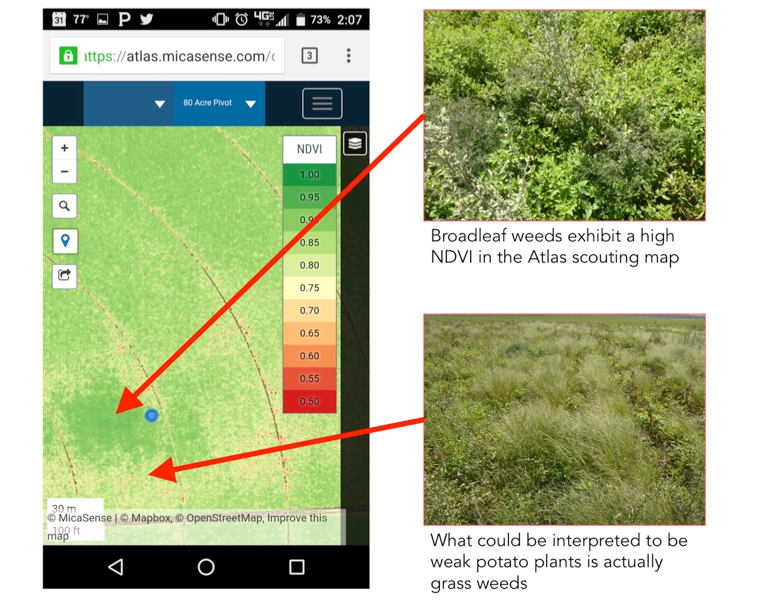When it all comes together, you gain invaluable insights. At the Drone Rodeo in Pendleton, Oregon, we showed that to make sense of NDVI, context is crucial, and color composite layers help fill in the blanks with key contextual details.
Stahl Farms provided the field: an 80 acre potato pivot in Pendleton’s UAS Test Range. The goal: explore, test, and apply cutting-edge precision agriculture technology to provide accurate, useful, insightful analysis.
It started with data collection. ATI equipped their AgBot drone with a MicaSense series RedEdge calibrated multispectral camera and produced several geo-referenced maps and analytical tools, including various color composites and vegetation indices (like NDVI).
 The AgBot and RedEdge
The AgBot and RedEdge
Now, NDVI is a great start but if you really want to know what’s going on, you have to get down into the weeds (literally). These tools don’t replace field scouting- they guide it. “It’s good for an indication of where there might be a problem, but it won’t tell you anything about the nature of that problem,” says remote sensing expert , Dr. John Sulik.
“NDVI is a great start but if you really want to know what’s going on, you have to get down into the weeds (literally).
For example, in one part of the field, the NDVI map exposed a healthy green patch surrounded by a weak patch of yellow. Any agronomist could look at the data and reasonably assume that this area contained healthy potatoes surrounded by less healthy crops, but all Dr. Sulik found were beautiful, healthy weeds. “There were two types of leaf structures: broadleaf weeds and grasses. Broadleaves are typically flatter and that’s why that one patch has really high NDVI. Grasses are more vertical and do not reflect much near-infrared light.”

Further analysis of the data for the potato field revealed even more. The Chlorophyll Map layer highlighted variability in the field that did not appear in NDVI or in standard color (RGB) aerial images. Sure enough, an analysis of the soil types revealed that the unhealthy areas in the eastern portion had sandier soil than the rest of the field. In this case, being able to see his GPS location on the map made a big difference, “It’s not fun to walk an 80 acre pivot in sandy loam soil. If you know exactly where you need to go in that field, it saves you a whole lot of effort,” he said.
Dr. Sulik also compared RedEdge data captured by Digital Harvest over the same potato field on two separate dates and discovered a few areas that exhibited a drastic loss in NDVI over the course of about 3 weeks. Was this caused by too much water, or was it too little? Was a nutrient deficiency to blame?
“If you want a quantitative device … then you want an index. If you want to start interpreting a map, you’re better off with a composite.
— Dr. John Sulik
He used the NRG color composite layer to bring out variability and highlight textural image information that simply does not exist in indexes like NDVI. Using NRG, he could clearly see darker, wetter soil in the problem area. Scouting the area, he confirmed the presence of standing water. “If you want a quantitative device for coming up with prescriptions … then you want an index. If you want to start interpreting a map, you’re better off with a composite,” says Dr. Sulik.


The NRG color composite shows more clearly what the NDVI map does not: that the area of low NDVI detected is actually an over-abundance of water that has killed the plants. The dark purple color in the NRG indicates areas of water-saturated soil.
To create some of the more useful color composites such as NRG, the camera you are using needs to not only capture near-infrared and red light, but it must capture green light as well (that “G” in NRG stands for “Green”, by the way). You might think this is standard, but many popular converted cameras are designed with NDVI in mind (which doesn’t use green light at all), so often the green band is filtered out entirely or, when it isn’t, it’s too noisy to be useful.
“Different bands allow you to create different color composites, which bring out different types of variability,” says Dr. Sulik. “It helps you reason and think through how you’re going to go scout, or what the issue might be.”





